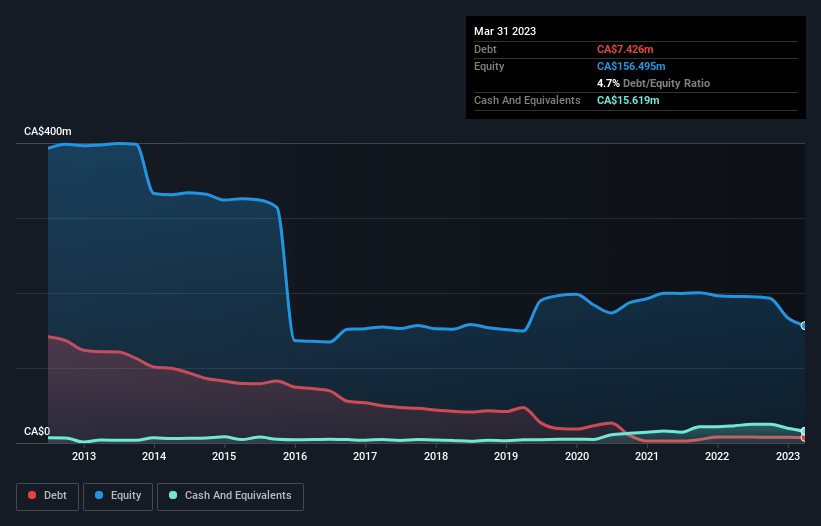Warren Buffett famously said, 'Volatility is far from synonymous with risk.' So it might be obvious that you need to consider debt, when you think about how risky any given stock is, because too much debt can sink a company. As with many other companies Glacier Media Inc. (TSE:GVC) makes use of debt. But should shareholders be worried about its use of debt?
When Is Debt Dangerous?
Generally speaking, debt only becomes a real problem when a company can't easily pay it off, either by raising capital or with its own cash flow. In the worst case scenario, a company can go bankrupt if it cannot pay its creditors. However, a more usual (but still expensive) situation is where a company must dilute shareholders at a cheap share price simply to get debt under control. By replacing dilution, though, debt can be an extremely good tool for businesses that need capital to invest in growth at high rates of return. The first thing to do when considering how much debt a business uses is to look at its cash and debt together.
Check out our latest analysis for Glacier Media
What Is Glacier Media's Debt?
You can click the graphic below for the historical numbers, but it shows that Glacier Media had CA$7.43m of debt in March 2023, down from CA$7.95m, one year before. However, it does have CA$15.6m in cash offsetting this, leading to net cash of CA$8.19m.

A Look At Glacier Media's Liabilities
Zooming in on the latest balance sheet data, we can see that Glacier Media had liabilities of CA$44.5m due within 12 months and liabilities of CA$21.6m due beyond that. On the other hand, it had cash of CA$15.6m and CA$31.4m worth of receivables due within a year. So its liabilities outweigh the sum of its cash and (near-term) receivables by CA$19.2m.
This deficit is considerable relative to its market capitalization of CA$22.3m, so it does suggest shareholders should keep an eye on Glacier Media's use of debt. This suggests shareholders would be heavily diluted if the company needed to shore up its balance sheet in a hurry. Despite its noteworthy liabilities, Glacier Media boasts net cash, so it's fair to say it does not have a heavy debt load! When analysing debt levels, the balance sheet is the obvious place to start. But it is Glacier Media's earnings that will influence how the balance sheet holds up in the future. So if you're keen to discover more about its earnings, it might be worth checking out this graph of its long term earnings trend.
Over 12 months, Glacier Media reported revenue of CA$173m, which is a gain of 3.4%, although it did not report any earnings before interest and tax. We usually like to see faster growth from unprofitable companies, but each to their own.
So How Risky Is Glacier Media?
We have no doubt that loss making companies are, in general, riskier than profitable ones. And the fact is that over the last twelve months Glacier Media lost money at the earnings before interest and tax (EBIT) line. And over the same period it saw negative free cash outflow of CA$2.2m and booked a CA$34m accounting loss. With only CA$8.19m on the balance sheet, it would appear that its going to need to raise capital again soon. Summing up, we're a little skeptical of this one, as it seems fairly risky in the absence of free cashflow. The balance sheet is clearly the area to focus on when you are analysing debt. But ultimately, every company can contain risks that exist outside of the balance sheet. To that end, you should learn about the 3 warning signs we've spotted with Glacier Media (including 1 which can't be ignored) .
At the end of the day, it's often better to focus on companies that are free from net debt. You can access our special list of such companies (all with a track record of profit growth). It's free.
New: Manage All Your Stock Portfolios in One Place
We've created the ultimate portfolio companion for stock investors, and it's free.
• Connect an unlimited number of Portfolios and see your total in one currency
• Be alerted to new Warning Signs or Risks via email or mobile
• Track the Fair Value of your stocks
Have feedback on this article? Concerned about the content? Get in touch with us directly. Alternatively, email editorial-team (at) simplywallst.com.
This article by Simply Wall St is general in nature. We provide commentary based on historical data and analyst forecasts only using an unbiased methodology and our articles are not intended to be financial advice. It does not constitute a recommendation to buy or sell any stock, and does not take account of your objectives, or your financial situation. We aim to bring you long-term focused analysis driven by fundamental data. Note that our analysis may not factor in the latest price-sensitive company announcements or qualitative material. Simply Wall St has no position in any stocks mentioned.
About TSX:GVC
Glacier Media
Operates as an information and marketing solutions company in Canada and the United States.
Mediocre balance sheet and slightly overvalued.
Similar Companies
Market Insights
Community Narratives



